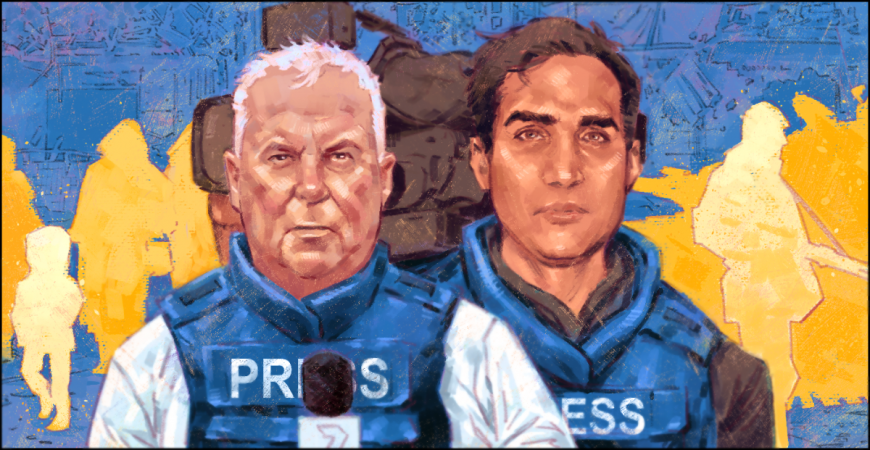Although they won’t admit it and tend to shy away from the phrase ‘risking their lives’, it’s got to be acknowledged that members of the Perth media are reporting on the frontline in Ukraine to seek the truth for us watching from the safety of our own homes.
“In every conflict I've been to, there've been deaths amongst the journos. I mean, everyone gets frightened, I think, when the bullets are flying. That's just human nature. You try not to think about it and put it aside to do your job,” says veteran 7 News journalist Geof Parry.
Those were Geof’s intrepid words to me when I spoke to him at the weekend, just hours before Russian missiles hit Lviv, the city where Geof has been based since Putin invaded Ukraine.
By his side when those air sirens went off at 6am Friday (local time), was 7 News Perth cameraman Simon Hydzik who had only just returned to the usually safe Lviv after doing a three-week stint with reporter Chris Reason in the war-ravaged Kyiv.
“In warzones situations can change very quickly,” Simon says.
“We went and we obviously had a look at the damage and that is scary because you don't know whether there's going to be another missile because they missed the target. So, you are on edge …and you kind of never know where the Russians might be.”
I wanted to share the pair’s journey for two reasons. Firstly, this is a war shrouded with propaganda and misinformation and it’s important to understand how vital it is to have journalists and camera operators we know and trust seeking out real, first-hand accounts of what is happening.
Regardless of whether you consume news or not, whatever happens in Ukraine will have a significant impact on the world and our lives. The actions will – and do – impact our politics, economy and social structures.
And in case you’ve been under a rock for the last month, every action has a significant impact to millions of people across the globe - the growing fuel price is a prime example and I think it can be argued that the public, politicians and even businesses are basing their choices and decisions on the information they receive.
It’s all connected and that is why it is vital we have trustworthy people on the ground to bring us the information.
But secondly, I also want to credit and acknowledge the media given the dangerous situations and long hours they face, away from their families, to bring us truth.
“Haven't missed a day, actually. We've worked every day since the last 31 days,” Geof says.
“I usually start around five in the afternoon. I'm on air around 8:30 that evening and will go through until about one in the morning. And then I get a few hours’ sleep, and then we'd be back on air, we'd be up around seven the next morning. So we're doing both ends of the day.”
In the first three weeks since Simon arrived in Kyiv his crew were pulling up to 18-hour days.
“If one crew is doing Sunrise and breakfast TV crosses, they can pretty much work from six in the morning, all the way until midnight, which can be some very long days but it's not really sustainable for three weeks,” Simon says.
“You kind of need everyone alert and watching for danger.”
“There was a time where we were filming just an area in the city where there had been a bit of a tank battle a few days prior and we saw two missiles sort of fly over the top of us. Then it hit a TV tower probably not more than a kilometre away,” he says.
Speaking to Simon, 38, who has never covered conflict before, he was very matter of fact about the dangers in Ukraine and assured me he and his crew would never intentionally risk their lives.
“Obviously warzones are dangerous but everyone in our team of five has families that they want to go back home to, every decision we make is based on getting out of Ukraine alive,” Simon says.
Ukraine's Prosecutor General announced the Unified Register of Pre-Trial Investigations indicated that the Russian military has committed crimes against at least 56 members of the media since the war began on February 24 and of those, 12 have been killed.
Geof, who has covered conflicts in South Africa, Somalia, Balkans, Fiji, East Timor, Indonesia, Iraq, and Afghanistan, says death comes with the territory of reporting on war.
“Back in East Timor, we discovered the body of a Dutch journo, a guy by the name of Sander Thoenes. There was a couple of us who got a tip-off that he'd been killed, and he was up country. So, we walked up there and found his body – just like Harry Burton in Afghanistan, who I knew, he was murdered trying to get to Kabul,” Geof recalls.
Before they even got into Ukraine, Geof and Simon had to prepare for the worst.
“We had to organise armour which you can't bring from the store in Australia. We also had to let our security know our blood types in case there's an emergency,” Simon says.
When they arrive, they are set up with security – but they are really only there to advise.
“It's pretty much just one person in our car that's with us, they are ex-military like the guy that we work with, he is a paratrooper, was in the military for 15 years. But he's also supported by a whole team of people that work for this company based in Lviv that provides information and intelligence,” Simon explains.
“When you hear the shelling in the background, it can be sort of in the distance but our security says, ‘Okay, I can hear it's getting closer or it's coming from this distance.’
“With hearing gunfire and that kind of thing you do have to be careful because obviously if you're hearing gun battles, you don't want to sort of suddenly drive through it.”
Simon, who has been a cameraman for 15 years, says he struggles to explain to his family that he doesn’t spend all day dodging bullets and that a lot of planning and training does go into their decision making.
“It's difficult because your parents will say, ‘Oh, I've had sleepless nights thinking about what's going on with you’, and how do you sort of convince them otherwise?” he asks.
It’s a tough job but we need people we trust doing it.
Geof explained to me that there is misinformation or what he calls ‘the fog of war’.
“A lot of it is just unclarified information, if you like. Everyone does it, you report what you know and what you believe. Sometimes that changes, but you’ve just got to be careful, and responsible, and don't over egg it. Don't try and sensationalise it,” Geof says.
“After a while, you hone your ‘BS’ metre. There's nothing's adding up, or there's a few things that don't add up on this, so just treat it with caution. But you have your trusted sources, or it's verified by government sources or intelligence, like the Pentagon.”
Simon says while working in Kyiv there was an abundance of videos floating around on social media.
“And no one really knows whether it was shot today or from three years ago. With us being on the ground it is kind of this automatic trust that it's not just a video that the Russian or Ukrainians have put on social media,” Simon says.
“If we hear of a missiles or attacks or even see one of these videos online, we can go to the scene and verify if it actually happened. We have our reporters standing next to the damage and I can send back the authentic vision and viewers can say ‘okay well those pictures are from today’.
“I really enjoy flying the drone, as dangerous and nervous as it makes me feel flying drones in a war zone, it just gives our coverage a whole new dimension.”
Simon recalls one of his most memorable moments was when they were called to interview seven Russian prisoners of war.
“We had this bizarre press conference where they rolled out a couple of the Russian prisoners. They weren't in handcuffs or anything like that. They were just all lined up at a desk and we could go up to them and get shots of them, which is probably the closest that we've come to any Russian,” Simon says.
Although valiant in their descriptions that what they are doing is just their jobs, both Simon and Geof are not immune to the emotional sights of war.
“I've had tears in my eyes, that's for sure, and it's probably sometimes the things that you wouldn't really expect to affect you. In Kyiv, we were shooting a lot of the people desperate to get on trains and evacuate. It was quite emotional to see these families and young kids. Holding their little dog tight or a cat in a cat carrier, just take everything that's important to them and just trying to get out of there and just so desperate,” Simon says.
Geof says he struggles witnessing the impact on children.
“And mums, their husbands have been left behind, and some of them have left sons behind, because they're of military age. So, there's plenty of tears at those places. And plenty of angst and plenty of uncertainty for these people,” Geof says.
“The scale of, it's what, three and a half million now gone over the border, and a total of 10 million internally displaced people, it's just staggering numbers. So, that's all pretty sad stuff.”
But Geof says there are also the beautiful moments.
“As a country, the resolve and the confidence that they'll pull this off, is just remarkable. And in the early days, the first week or two of the war no one thought that they could respond in the way that they have. And I just mean because of the numerical disadvantage. But, they have just completely bamboozled the Russians,” Geof says.
The pair don’t know how long they will remain in Ukraine and with so much uncertainty on what will happen next, it’s hard to predict what they face.
Geof, however, gave me his guess on the future of Ukraine and Russia.
“Well, I've been wrong before. Bec. But I'll stick my neck out, a long protracted military involvement, involving both countries. I think it's remarkable how hollow and how brittle the Russian army seems. People assume they were this fantastic, great army,” Geof says.
“And, I think they're just digging in. I think they're digging in, for a long siege. Which is unfortunate, but I think that's the way this one's going to work out, for a while, until they find some diplomatic solution.”
If it is a long siege the media is in for – we salute your efforts.
Stay safe.
 ReGen Strategic
ReGen Strategic